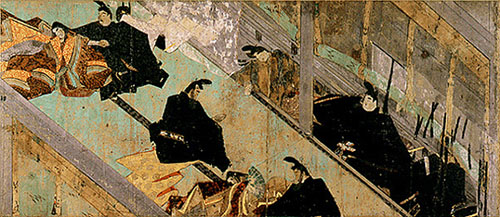Despite the close cultural (for example, use of a pictograph system for writing), political (similar ideas about the nature and power of an emperor) and economic (extensive trade exchange) ties between early Chinese and Japanese societies, the two developed in different geographical environments--that's no surprise--but also in their political practices. Historians still disagree upon the exact reasons for that, but clearly Japan's existence as an island society that was largely insulated from migrating peoples and invaders by the sea provided a much different environment than the Chinese experienced with the long borders and possible enemies that could invade at any time. By the twelfth century or so, Japan had developed as a fairly stable, advanced society.
The Japanese samurai warrior, probably the most well-known feature of medieval Japan in the west, was essentially similar to a medieval European knight, wielding similar weaponry, adhering to a strict moral code like chivalry, fighting for religion and emperor, and living as a noble. The samurai, just like a European knight, also underwent a long period of training in preparation for his career.
![]()
Some recommended online lectures and websites
- The Emergence of Japan
- Japanese History: A Chronological Outline
- Japan's Korea War: First Invasion (1592-1596)
- Nakasendo Highway: A Journey to the Heart of Japan is project that uses the Nakasendo highway, connecting Kyoto and Edo (Tokyo), as a metaphor to explore a variety of topics about Japanese history and culture.
- A Concise History of Korea and Japan by Charles Kimball
- The Samurai Archives: Japanese History page
- Check out Parker J. Fentress' excellent digital project on the Culture and Art of Muromachi Era Japan.
- Here's a story map that gives an introduction to Japan.
- For extra credit please suggest to your instructor a relevant website for this unit of the course. Send the title of the site, the URL and a brief explanation why you find the information interesting and applicable to the material being studied in this unit.
